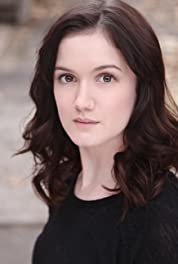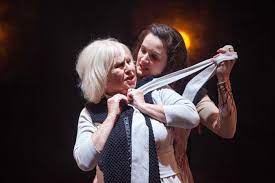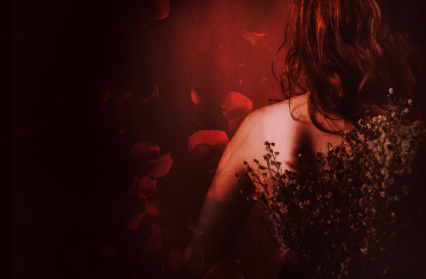Emily Vanderploeg casts a critical eye over Theatr Pena’s Woman of Flowers starring Sara Gregory and Betsan Llwyd.
As the house lights come up at the close of Theatr Pena’s Woman of Flowers and theatre-goers begin to turn to each other, gathering coats as they get to their feet, the general murmurings of the audience seem to follow a theme of, “Well – that was rather sexy.” And so this production is. This is largely down to the strong performance of Sara Gregory, whose title character, Blodeuwedd, exudes sensuality and the agony of repression. Gregory’s physicality on stage, a combination of writhing, yearning dance, and childish frustration, electrifies each of her scenes.

Movement Director Caroline Lamb seamlessly weaves brief moments of dance into the narrative, suggesting this story would lend itself well to a ballet or contemporary dance piece. The solid physicality of Betsan Llwyd’s performance, in contrast with Eiry Thomas’ androgynous-anamorphous and physically fluid, yet strong Gwydion, is also striking, which makes the wooden quality of Rhys Meredith’s Gronw, in particular, stand out. In his scenes of passion with Blodeuwedd he comes alive, and yet his voice and stance are at other times curiously stolid and monotone. Similarly, Oliver Morgan-Thomas’s Llew also lacks the strong physical presence of the women on stage. Was this a deliberate instruction from Director Erica Eirion? Or do the female performers of this production, as in the myths they tell, simply overshadow the men with their strength?
All of the performances, however, were bolstered by the visually striking production. Holly McCarthy’s costume design was well-considered and both Arianrhod’s stiff and structured silver gown, and Blodeuwedd’s flowing slit-legged dress reflected their characters and were used to great effect by the actors in their performances.
Betsan Llwyd’s Arianrhod floated as a powerful, ethereal presence with her silver train, intentionally or not, often picking up the strewn red petals representing Blodeuwedd across the stage. Meanwhile, Sara Gregory’s physicality is aided by her flowing skirts, at times revealing her body, or acting as a skin she wished to shed, pulling at the tight, flower-printed flesh-toned fabric, whilst Olwen Rees’ Rhagnell used the woollen tunics to great affect as symbols of their constrictive roles and environments. Gwydion’s androgynous leather suit was also a strong addition to her/his character, as was Llew’s reincarnated form in skeletal-printed leather.

Meanwhile, Kay Haynes’ use of lighting combined with Holly McCarthy’s projections (with video editing by Ceri James) was reminiscent of Helen Sear’s recent exhibition at the Glynn Vivian, “The Rest is Smoke”, tying together repetitious images of the natural world to give the effect of being in Blodeuwedd’s longed-for woods, or Arianrhod’s tempestuous sea fort. Similarly, the use of both colour and monochrome in McCarthy’s design draws the eye to shifting focal points in the space of the stage, seamlessly enhancing the performances of the actors.
Siôn Eirian’s adaptation of Saunders Lewis’ source text, Blodeuwedd, is at times poetic with some truly powerful and beautifully wrought lines. However, perhaps its attempt at a faithful translation and adaptation sometimes makes for overly long speeches and monologues. There is a sense at times that the characters must fill us in on other details, or wholly separate myths of the Mabinogion in order to give more weight or understanding to the moment. This was distracting and despite the strong delivery of the text by the actors, there needed to be more action and less telling of the story. It is understandable that there are limits to how much of the story can be told in the space of the stage, particularly in a one-act play. Yet it felt like a wasted opportunity to not bring in more of the strong physical presence of the actors in the telling, such as in Blodeuwedd and Gronw’s sexual dance sequence, or the murder of Llew.
With such dense and complex connections and threads of narrative in the interconnected Mabinogion myths, it is a tall order to achieve and the desire to have the audience just know the whole story in order to ‘get it’, is conflicting. Do we need to know each part of the myth in such detail, such as Llew’s birth, prophecies, and the backstory of Gwydion and Arianrhod’s youth? Or could they have been told in more than words, such as utilising the excellent audio and projection, or the movement work of the actors?
Woman of Flowers’ strength is its visually striking production and the intensity of Sara Gregory’s and Betsan Llwyd’s performances. All of the actors are to be commended for communicating a demanding text with such energy and intensity, though the female characters here showed particular strength. This is a polished and intense production, with a sensual, physical backbone that is illuminated by the clever visual design and the swathe of red that frames the stage – the Woman of Flowers gets her due, and Blodeuwedd wins our sympathy and understanding in this well-told modern adaptation by Theatr Pena.
Emily Vanderploeg is a theatre critic and contributor to Wales Arts Review.












